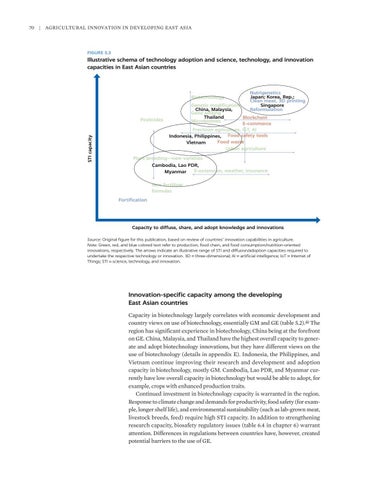70 | Agricultural Innovation in Developing East Asia
FIGURE 5.3
Illustrative schema of technology adoption and science, technology, and innovation capacities in East Asian countries
Biotechnology
STI capacity
Pesticides
Nutrigenetics Japan; Korea, Rep.; Clean meat, 3D printing Singapore Reformulation
Genetic modification China, Malaysia, Gene editing Thailand Blockchain Microbiomes E-commerce Precision agriculture, loT, o Al a tools Indonesia, Philippines, Food safety Food waste Vietnam Urban agriculture g
Plant breeding—new e varieties Cambodia, Lao PDR, E-extension, weather, insurance Myanmar New fertilizer formulas Fortification
Capacity to diffuse, share, and adopt knowledge and innovations Source: Original figure for this publication, based on review of countries’ innovation capabilities in agriculture. Note: Green, red, and blue colored text refer to production, food chain, and food consumption/nutrition-oriented innovations, respectively. The arrows indicate an illustrative range of STI and diffusion/adoption capacities required to undertake the respective technology or innovation. 3D = three-dimensional; AI = artificial intelligence; IoT = Internet of Things; STI = science, technology, and innovation.
Innovation-specific capacity among the developing East Asian countries Capacity in biotechnology largely correlates with economic development and country views on use of biotechnology, essentially GM and GE (table 5.2).20 The region has significant experience in biotechnology, China being at the forefront on GE. China, Malaysia, and Thailand have the highest overall capacity to generate and adopt biotechnology innovations, but they have different views on the use of biotechnology (details in appendix E). Indonesia, the Philippines, and Vietnam continue improving their research and development and adoption capacity in biotechnology, mostly GM. Cambodia, Lao PDR, and Myanmar currently have low overall capacity in biotechnology but would be able to adopt, for example, crops with enhanced production traits. Continued investment in biotechnology capacity is warranted in the region. Response to climate change and demands for productivity, food safety (for example, longer shelf life), and environmental sustainability (such as lab-grown meat, livestock breeds, feed) require high STI capacity. In addition to strengthening research capacity, biosafety regulatory issues (table 6.4 in chapter 6) warrant attention. Differences in regulations between countries have, however, created potential barriers to the use of GE.

